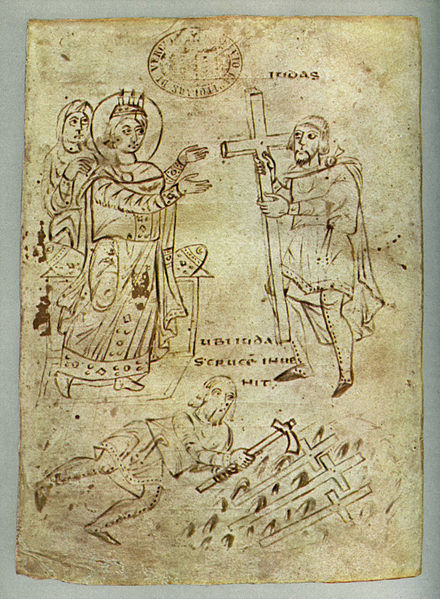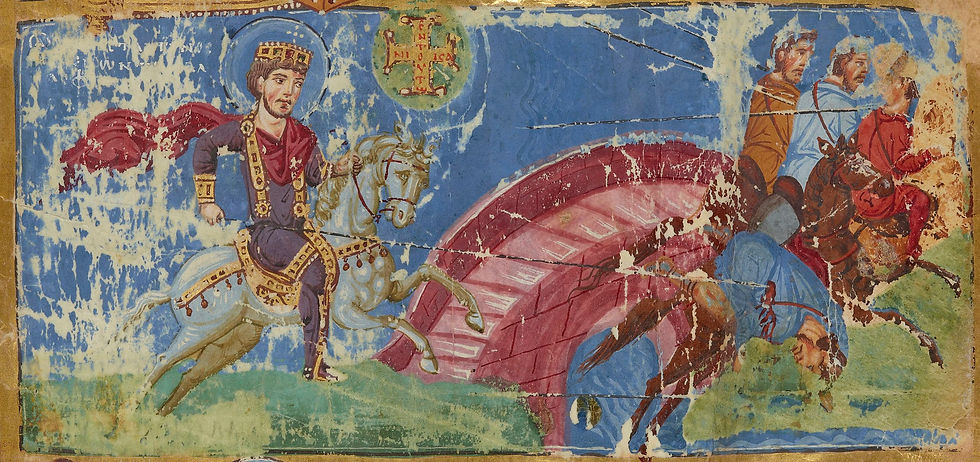Helena, Queen of Christians
- Nila Nmc
- Nov 24, 2020
- 5 min read
This week’s post is about a humble woman who became an empress and also a saint throughout her lifetime. A woman who devoted her life to Christ and influenced her spouse and only son to be tolerated towards this new notion in the Roman empire.
Helena was probably born in Bithynia, Asia Minor, around 246 to 248 CE as Procopius mentions, however, there is no certainty about her birthplace and early life. Furthermore, it is unknown where she first met her husband, Constantius. Nevertheless, there is a legend telling they might have met while Constantius was serving under Emperor Aurelian for the campaign against Zenobia in Asia Minor.
According to this legend, upon their spontaneous meeting, they were both wearing identical silver bracelets that made Constantius believe he found his soulmate sent by God. After their marriage, she gave birth to a son, the future patron of Christians, Constantine the Great.
She was the main reason for Constantine’s enthusiasm towards Christianity and also Constantius’s tolerance and sympathy for early Christians. As the account of Eusebius of Caesarea mentions, Helena was allegedly Christian and encouraged Constantius to believe Christians did not deserve to be persecuted. As a consequence, in his eyes they had done nothing to get persecuted; rather, they were worshiping their god likewise others within the empire.
Later on, Constantius and Helena got a divorce as he wanted to obtain a wife more consonant with his rising status. Hence, Helena together with his son was dispatched to the court of Diocletian in Nicomedia, where Constantine grew to be a member of the tetrarchy. Helena never remarried and stayed very close to his son, who had a deep love and affection for her.

Helena was brought back to the imperial court in 312 CE, after Constantine’s ascension to the throne and she received the title of Augusta in 325 CE. Moreover, she was given unlimited access to the imperial treasury to locate the relics of the Christian tradition. According to the account of Eusebius, she converted to Christianity following her son’s coronation.
Between 326-28 CE, Helena undertook a religious trip to Palestine, where she ordered the construction of two churches, the Church of the Nativity and the Church of Eleona, situated in Bethlehem and Month of Olives respectively.
The Church of Nativity is situated near a grotto, where Jesus was born according to the bible. The site was originally identified by Helena and Bishop Makarios of Jerusalem and the first basilica was built by Constantine the Great in 326. The early construction plan was part of a larger project following the first council of Nicaea that aimed to build various churches on the sites that assumed to have witnessed the crucial events of the life of Christ.
The Church of Eleona is another Byzantine monument dated to the 4th century that is situated on the Month of Olives, where Jesus was ascended to heaven. Today, only the remains of the original basilica have survived upon the olive grave on the site.
The most fascinating event during Helena’s pilgrimage was the discovery of the True Cross. At the time that she traveled to Jerusalem, there was a temple of Venus, built by Emperor Hadrian during 130s CE, over the supposed site of Jesus’s tomb. According to Eusebius, Helena ordered to tear the temple down and search for the Holy Sepulcher, where Christ was crucified and also the True Cross. This was why Constantine sent her to the Holy land in the first place. Her mission was to follow the footsteps of Jesus, by performing acts of kindness and good works such as giving money, food, and clothes to poor people. Moreover, as she had access to the imperial treasury, she was able to help churches by granting money.
After weeks of traveling around Palestine, she finally reached Jerusalem, aiming to find the True cross. Following the destruction of the Roman temple as legends say, she could finally find three crosses with the help of a man called Judas Cyriancus near Mount Calvary. Two of the crosses were thought to belong to the thieves who died in tandem with Jesus. So, Helena wanted to test and see which one truly belonged to Jesus Christ.

In order to recognize the original one, they searched for a leper at the outskirts of Jerusalem. Once one was found, the leper was instructed to touch each of the crosses one by one. He touched the first one and nothing happened. He also touched the second one but still, nothing happened. Finally, when he touched the last cross, the leper was instantly healed. Therefore, the last one is known as “The True Cross”.
Later on, the cross was carried back to Constantinople, while part of it was placed in the hands of the bishop of Jerusalem. Today, fragments of “The True Cross” are placed in various catholic churches around the world. We may never know whether the cross they found and distributed was The True Cross but, in the end, it is up to us whether believe the accounts or not.

There are other legends, telling about the nails of the crucifixion (relics that are claimed to be holy nails with which Jesus was crucified) found by Helena. According to these accounts, the nails were given to Constantine to use their miraculous power by placing one in his helmet and one in the bridle of his horse.
Lastly, Helena left Jerusalem and the eastern provinces in 327 CE to return to Rome, bringing with her large parts of the True Cross and other relics, which were then stored in her palace’s private chapel. Her palace was later converted into the basilica of the Holy Cross in Jerusalem.
Helena died around 330, with her son at her side. She was buried in the Mausoleum of Helena, located on via Labicana, just outside Rome. Today her stunning sarcophagus, made with Porphyry is on display in the Vatican Museum.
she was the very first Byzantine empress who dedicated her last years of life to pilgrimage and encouraged Constantine to choose Christianity as the religion of his empire. She was truly an inspiration to her family members who were part of the tetrarchy, in a time that Christianity was like hell and Christians seemed like demons to Pagans. Nevertheless, she encouraged them towards the light like an angel sent by God.
she truly deserves to be a saint and worshiped by orthodox people nowadays. I remember how much I got carried away, when I saw her enormous icon, standing together with Constantine in a small Orthodox church in Birmingham. Orthodox Christians kiss Helena and Constantine’s icons alongside the icons of Jesus and the Virgin Mary, every time they enter a church. It is like worshiping a holy mother and son in heaven and another mother and son on earth.




Comments